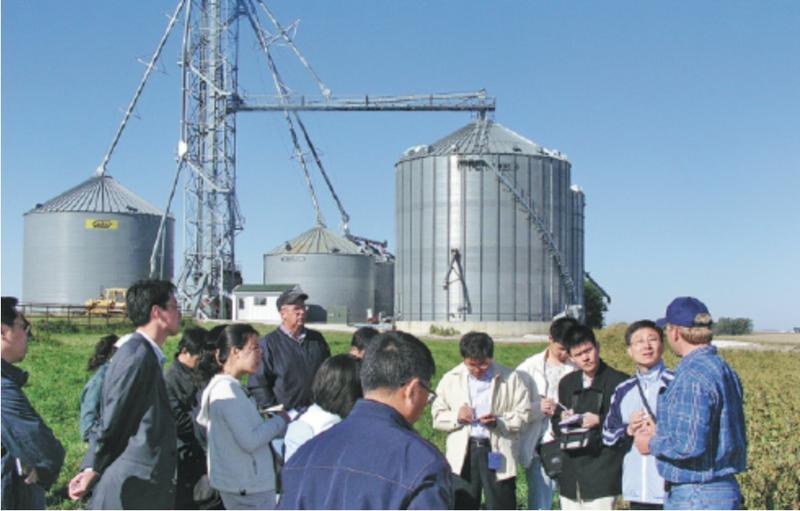 The US Soybean Export Council organizes a group of Chinese soybean importers to visit US soybean farms in 2006, in a bid to help them learn about the industry there. (PHOTO PROVIDED TO CHINA DAILY)
The US Soybean Export Council organizes a group of Chinese soybean importers to visit US soybean farms in 2006, in a bid to help them learn about the industry there. (PHOTO PROVIDED TO CHINA DAILY)
Protein is an essential ingredient of any healthy diet. And over the past few decades, Chinese people have rapidly increased their consumption of meat, meaning that the production of meat has had grow to meet demand. In order to do this, pigs, for example, need to be fed. A crucial ingredient in pig feed is soybeans. Step in, the US Soybean Export Council.
Meat consumption in China, excluding seafood, increased from 7 million metric tons in 1975 to 86.5 million tons in 2018, making the country the largest consumer of meat globally, according to the Center for Strategic & International Studies, a think tank based in the United States.
The increased meat consumption has not just come about because people's tastes have evolved, but rather China has risen from being a relatively poor nation to one of the world's largest economies.
In the past decade, the proportion of undernourished people in China has dropped from 16.2 percent to 8.6 percent, according to the Food and Agricultural Organization of the United Nations. And the country was one of only a few countries to meet the FAO's target to cut hunger rates by half.
ALSO READ: China's soybean imports will keep increasing
The progress is the result of joint efforts among multiple stakeholders. Among them, the China-US soybean trade has played a key role, with exchanges dating back to 1977.
"I think it was evident to the delegations and leadership (in 1977) that collaboration would be mutually beneficial," said Zhang Xiaoping, director of the US Soybean Export Council Greater China.
The exchanges in 1977 initiated a 38-year partnership to study and learn from US soybean, aquaculture and livestock production, research and growth.
Zhang Xiaoping, director of the US Soybean Export Council Greater China
"The exchanges in 1977 initiated a 38-year partnership to study and learn from US soybean, aquaculture and livestock production, research and growth."
Guangming Pig Farm in South China's Guangdong province teamed up with the Singapore office of the American Soybean Association, the US Soybean Export Council's predecessor, and Don Bushman, a notable nutrition professional, to develop soybean feed formulations in the early 1980s.
With the new formulations providing promising results, soybean-based feed became a more viable option for pig farmers in China, resulting in the feed businesses booming in southeastern coastal areas.
And it wasn't just the pig farming industry that benefited from cooperation with the US Soybean Export Council, with efforts ramped up in the poultry sector to provide expertise and help train more professionals for the modernization of China's poultry industry.
The activities included more than 70 seminars on and training in breeding, nutrition, management, biosecurity, feed additives and breeding.
According to Zhang, before the introduction and promotion of US soybean industry practices, only a few of farmers in China had the idea of some products and production practices that are key to increasing profitability and efficiency, such as using corn-soymeal rations, full-fat soybean meal, de-hulled soybean meal and low-volume high-density cage aquaculture.
Statistics show that China's aquaculture production increased from 1.35 million tons in 1980 to more than 38 million tons in 2010.
Representatives of the US soybean industry held feeding demonstrations in China to share information on how to take advantage and make the most of the feed, such as using extruded pellets.
These technologies are examples of how the US soybean industry has been contributing to China's food safety, said Jim Sutter, CEO of the US Soybean Export Council.
Looking ahead, with achievements made by the partnership among Chinese and US livestock nutritionists, production specialists and industry leaders, the US Soybean Export Council will continue to partner with China to further improve both sides' research and innovation in soybeans.
READ MORE: Breakthroughs in tech lift soybean production
This is a sponsored story.


